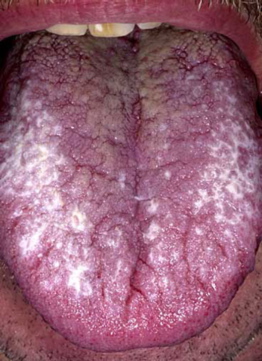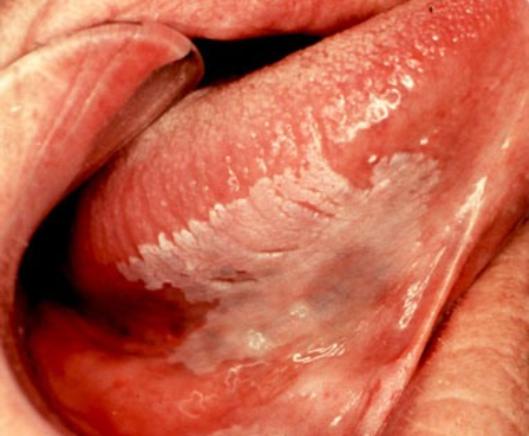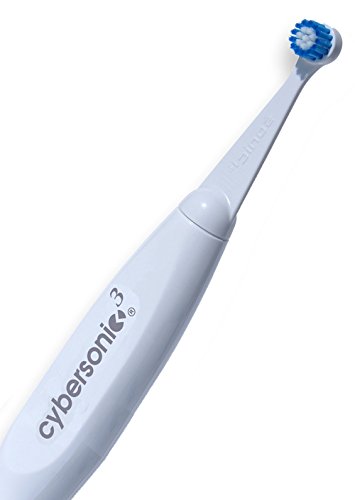Oral Hairy Leukoplakia
Oral hairy leukoplakia is basically a white patch on the soft tissues anywhere in your mouth. The most common areas are on the sides of your tongue, usually on both sides; or else UNDER your tongue, (dentists call it "the floor of the mouth"), and lastly on the insides of your cheeks.
To see these areas properly, you have to look in a mirror in a good light, and lift your tongue up so the tip of your tongue touched the roof of your mouth. Now you can see under your tongue properly. Then move the tip of your tongue slowly from one side to the other to see each side.
The white areas can vary in size from as little as 2 to 3 millimeters across up to as much as 10 millimeters (one centimeter) or more across.
The exact color of the patch can vary from a pale white or grey shade all the way to a dense white. This is a REALLY dense white color. The paler color patches are frequently flat and level with the surrounding area.
The more dense white patches may be slightly raised, and can have a firm surface that you can feel clearly with your finger. It may even feel a little more rough than the surrounding tongue surface.
Oral hairy leukoplakia is usually completely painless, but sometimes it may be a little tender to hot drinks or food, or to spicy foods. The area is persistant, and is more common in young adult males.
What's the cause of oral hairy leukoplakia?
The CAUSE is almost always an overgrowth (hyperplasia) of the oral epithelium with production of excess keratin caused by the Epstein-Barr virus.
It occurs most commonly in individuals with compromised immunity, as a result of human immunodeficiency virus (HIV) infection.
But we don't like white patches in the mouth, because they can sometimes be a starting point for an ORAL CANCER to develop later.
So while a leukoplakia itself is entirely harmless, we want to establish what is causing it, and eliminate the cause.
 white patches
white patchesRemember to check out my top recommended electric toothbrush, which has the best performance and a great price at Amazon - the Cybersonic 3 brush.
Oral Hairy Leukoplakia
Things that it may be confused with include:
- Frictional keratosis, from a rough surface inside the mouth.
- A cinnamon oil allergy.
- Plaque - type lichen planus.
- Chronic hyperplastic candadiasis (a candida infection)
- Smoking- related leukoplakia
Are there any other factors? Yes; it's seen more often in young male adults rather than older folk (typically over 50 years of age).
Also, people who smoke cigarettes, cigars or pipes seem to be more affected too. In some cases, the irritation causing the white patch is due 100% to smoking, and has nothing to do with any rough teeth or dentures rubbing.
This called a smoking-related leukoplakia.
The clue to this is exactly where the white patch is located. If it lines up with a rough tooth edge or denture edge when the mouth is at rest, then it's almost certainly due to that particular tooth or denture.
 Leukoplakia under the tongue, on one side.
Leukoplakia under the tongue, on one side.On the other hand, if the patch doesn't really line up with anything inside the mouth, but is near to the point where the person tends to hold their cigarette or pipe, then we can make an educated guess that smoking is the cause.
How is a definite diagnosis made? The only way to make a firm diagnosis is to make a small biopsy of the patch. If it is very small, it may be removed completely. If it is quite big, just a small section will be taken. The laboratory can examine the biopsy under a microscope, and say with a degree of certainty what the cause is.
What's the treatment? The treatment is relatively simple - get rid of the cause! Because the cause is frequently something rough in the mouth, all we have to do is focus on any rough teeth, fillings or dentures that are close to the white patch.
If the biopsy shows infection with the Epstein-Barr virus, then high-dose Acyclovir (Zovirax) may be effective, but the leukoplakia often returns when treatment is stopped.
If it is down to frictional keratosis, once we identify the potential tooth or teeth, we just have to replace any rough or broken fillings, and polish any rough edges.
A few years ago, I was asked by a specialist in oral medicine to replace some old fillings for a patient with a white patch on her cheek.
I asked him what filling material he would prefer me to use for the new fillings. I ALWAYS REMEMBER HIS REPLY - "I don't care, as long as it is as smooth as glass". AS SMOOTH AS GLASS.
That just shows how important any roughness can be, in the eyes of an expert!
We also have to check the dentures (if present) for rough or sharp edges, and correct anything we find that isn't "as smooth as glass". ALSO we always have to advise stopping smoking. Even if the leukoplakia seems to be linked to a rough tooth, smoking will make it worse. Stopping smoking is extremely important.
So leukoplakias are usually harmless, and the white patch usually goes away in a few weeks or months after the source of irritation is removed. If getting rid of the source of the irritation doesn't help, the patch may need to be surgically removed.
This can be done either by your general dentist or by an oral surgeon with local anesthesia. Most general dentists would probably want to refer you to a specialist, even though it's a simple procedure.
An HIV infected individual with a hairy leukoplakia is likely to develop AIDS within 2 years.
Hairy leukoplakia requires treatment with an antiviral medication, by an oral medicine specialist.
As always, if you see a white patch anywhere in your mouth, go and get it checked by a dentist. These things are usually innocent and harmless, but sometimes a white patch may be serious, and it is MUCH EASIER to treat the earlier it is detected!
You can read more about other white patches at my page White patches.




